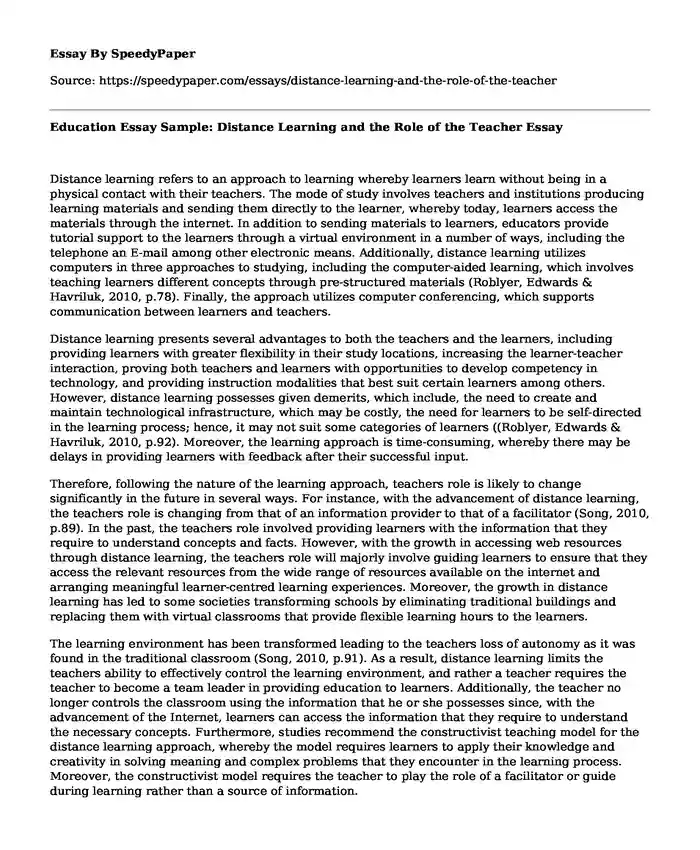Distance learning refers to an approach to learning whereby learners learn without being in a physical contact with their teachers. The mode of study involves teachers and institutions producing learning materials and sending them directly to the learner, whereby today, learners access the materials through the internet. In addition to sending materials to learners, educators provide tutorial support to the learners through a virtual environment in a number of ways, including the telephone an E-mail among other electronic means. Additionally, distance learning utilizes computers in three approaches to studying, including the computer-aided learning, which involves teaching learners different concepts through pre-structured materials (Roblyer, Edwards & Havriluk, 2010, p.78). Finally, the approach utilizes computer conferencing, which supports communication between learners and teachers.
Distance learning presents several advantages to both the teachers and the learners, including providing learners with greater flexibility in their study locations, increasing the learner-teacher interaction, proving both teachers and learners with opportunities to develop competency in technology, and providing instruction modalities that best suit certain learners among others. However, distance learning possesses given demerits, which include, the need to create and maintain technological infrastructure, which may be costly, the need for learners to be self-directed in the learning process; hence, it may not suit some categories of learners ((Roblyer, Edwards & Havriluk, 2010, p.92). Moreover, the learning approach is time-consuming, whereby there may be delays in providing learners with feedback after their successful input.
Therefore, following the nature of the learning approach, teachers role is likely to change significantly in the future in several ways. For instance, with the advancement of distance learning, the teachers role is changing from that of an information provider to that of a facilitator (Song, 2010, p.89). In the past, the teachers role involved providing learners with the information that they require to understand concepts and facts. However, with the growth in accessing web resources through distance learning, the teachers role will majorly involve guiding learners to ensure that they access the relevant resources from the wide range of resources available on the internet and arranging meaningful learner-centred learning experiences. Moreover, the growth in distance learning has led to some societies transforming schools by eliminating traditional buildings and replacing them with virtual classrooms that provide flexible learning hours to the learners.
The learning environment has been transformed leading to the teachers loss of autonomy as it was found in the traditional classroom (Song, 2010, p.91). As a result, distance learning limits the teachers ability to effectively control the learning environment, and rather a teacher requires the teacher to become a team leader in providing education to learners. Additionally, the teacher no longer controls the classroom using the information that he or she possesses since, with the advancement of the Internet, learners can access the information that they require to understand the necessary concepts. Furthermore, studies recommend the constructivist teaching model for the distance learning approach, whereby the model requires learners to apply their knowledge and creativity in solving meaning and complex problems that they encounter in the learning process. Moreover, the constructivist model requires the teacher to play the role of a facilitator or guide during learning rather than a source of information.
In conclusion, the teachers role in the future will involve arranging the learning environment in a manner that provides learners with situations that allow learners to utilize their knowledge and creativity in constructing meaning to the problems that they encounter during learning. Moreover, the teacher will be responsible for creating an active learning environment rather than a passive environment to ensure that the pre-determined learning objectives are achieved.
References
Roblyer, M. D., Edwards, J., & Havriluk, M. A. (2010). Integrating educational technology into teaching.
Song, H. (2010). Distance learning technology, current instruction, and the future of education : applications of today, practices of tomorrow. Hershey, PA: Information Science Reference.
Cite this page
Education Essay Sample: Distance Learning and the Role of the Teacher. (2019, Oct 31). Retrieved from https://speedypaper.net/essays/distance-learning-and-the-role-of-the-teacher
Request Removal
If you are the original author of this essay and no longer wish to have it published on the SpeedyPaper website, please click below to request its removal:
- Essay Example for Free: New Economy Research
- Essay Example on Preventing System Failures
- Employee Recruitment and Development in Deloitte, HRM Essay Sample
- Free Essay on Isaac Newton's Biography and Discoveries
- Essay Sample: The Life and Times of Elsa Schiaparelli
- Paper Example on Raising Children Who Think for Themselves
- Essay Example. Human Resource Policy Project
Popular categories





